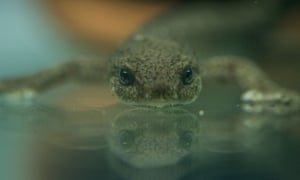For all of its centuries-long history, Boston has been a harbor town, a city built on fishing and trade. With such an intimate history with the sea, it's no surprise that the city boasts a world-class aquarium, located directly on the waterfront. Opened in 1969, the New England Aquarium is one of the great aquariums of the northeastern United States.
The fun of exploring the aquarium begins before a visitor has even purchased his or her ticket. Outside of the main building is a stand-alone habitat for
harbor seals. The handsome little pinnipeds, natives of the Boston area, can be observed above or below the surface of the water. Training demonstrations occur frequently, allowing visitors to watch as aquarium staff interact with the marine mammals to practice behaviors which allow the seals to assist in their own care and management.

More seals and sea lions can be seen in the New Balance Foundation Marine Mammal Center, adjacent to the main aquarium. Here, California sea lions can be observed in an open-air pavilion where, like the harbor seals, frequent training demonstrations occur. The sea lions are joined by northern fur seals - a species that is very seldom seen in American collections. These were the first fur seals that I'd ever seen, as I was completely taken in by them - so much smaller, sleeker, and (to shed objectivity) so much cuter than the more common Californians. They also looked so soft and touchable... which, as a nearby docent was happy to point out, using a sample pelt as a prop, is exactly what led to their massive decline as they were hunted for their namesake furs.

Stepping into the main aquarium, the eye is immediately drawn to the literal and metaphorical heart of the aquarium - the Giant Ocean Tank. Reopening in 2013 after extensive renovations, this 200,000 gallon habitat forms the core around which the rest of the aquarium is built. Spiraling walkways encircle it, allow visitors to get eye-to-eye with
loggerhead turtles, bonnethead sharks, moray eels, and a host of other ocean-dwellers in a recreated Caribbean reef. The climb eventually ends at the top of the tank, where you may watch
divers enter the tank of feed and service the enclosure, or listen to an educational presentation.
Huddled around the base of the Giant Ocean Tank are three separate habitats for penguins from around the world.
African penguins, rockhopper penguins, and
little blue penguins - the world's smallest species - inhabit pools studded with rocky islands for them to climb across. Little blues are uncommon in zoo collections - this was only my second time ever seeing them, which was a treat... although I was unfortunately there during their annual molt, which meant that most of them looked like they had just fallen out of a laundry machine after a double-spin cycle.
Other galleries line the various levels of the aquarium - guests progress up the central ramp around the Giant Ocean Tank, hopping off as the mood strikes them on one floor or another. The Temperate Gallery has an attractive display of schooling bait-fish, but the stars in the eyes of most visitors are likely either to be the massive
Goliath grouper (which looks like it could - and maybe just did - swallow a kindergartner for breakfast), as well as the ethereal sea-dragons - both the weedy and the
leafy - drifting in a rounded tank among strands of kelp. The Northern Waters Gallery is dominated by a massive
giant Pacific octopus, as well as
lobsters (this is Boston, after all), and an attractive aviary of non-releasable shorebirds. The Freshwater Gallery displays creatures of the Amazon, including such aquarium favorites as
anaconda,
piranha, and
electric eel, as well as salmon. There is also a
touch tank replication of sea life of the New England coast. Also present is an exhibit of Asian arowana, I species I first learned about through Emily Voigt's excellent book,
The Dragon Behind the Glass.
As with many aquariums, New England tries to engage its visitors with rotating exhibits - at the time of my visit, the theme was "The Science of Sharks", with a touch tank of small sharks and a series of interactive exhibits on the ocean's most famous predators. Past rotating displays have featured jellyfish and turtles
Like most of the larger,
AZA-affiliated aquariums, the New England Aquarium is active with the rehabilitation of marine life. most of which is done off-exhibit. It also maintains a specialized rehab center for porpoises, located outside of the city.
As a final treat, New England Aquarium boasts of a
spectacular wildlife viewing opportunity that makes it very worthwhile for a whole day of enjoyment.
Boston is a fine old city with many exciting historical and cultural attractions to enjoy, A visit to the city, however, wouldn't be complete with an exploration of its natural heritage as well, and the New England Aquarium is fine place for that exploration to begin.















